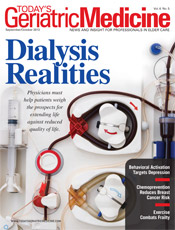
September/October 2013
Readmission of Medicare Patients as a Quality MeasureBy Joseph G. Ouslander, MD Reducing unnecessary hospital readmissions for Medicare beneficiaries currently is a major focus of almost every federal health care agency. Theoretically, such reductions will help achieve the “triple aim” articulated by Donald Berwick, MD, former administrator of the Centers for Medicare & Medicaid Services (CMS): improve care, improve health, and make care more affordable. The federal Partnership for Patients (http://partnershipforpatients.cms.gov) has two goals that highlight this focus: reduce 30-day hospital readmissions and reduce hospital-acquired complications. What better way is there to prevent hospital-acquired complications in older patients than to not admit them to the hospital in the first place? Reducing unnecessary hospital admissions is a laudable goal. If done properly, it will help achieve the triple aim. New approaches to Medicare financing are beginning to undermine the perverse financial incentives in the Medicare fee-for-service system that commonly drive inappropriate, expensive, and sometimes hazardous diagnostic and therapeutic procedures, including hospitalization. These changes are forcing hospitals, post-acute care facilities, home health agencies, physicians, and other health care providers to break down their silos, collaborate, and hold some accountability for what happens during transitions between care settings. Efforts are under way across the United States to implement a variety of interventions with the support of grants and contracts from the CMS Innovations Center and Medicare-Medicaid Coordination Office. Geriatrics health care professionals have developed many of these interventions, such as the Program for All-Inclusive Care of the Elderly (PACE); comprehensive community-based geriatric assessment and management interventions that can be incorporated into medical homes and accountable care organizations, such as Geriatric Resources for Assessment and Care of Elders (GRACE) and Guided Care; Acute Care for Elders (ACE) hospital units; care transition interventions such as the transitional care model and the care transitions intervention; and Interventions to Reduce Acute Care Transfers (INTERACT). Continuing Concerns Second, myriad factors may contribute to hospital readmissions among complex older Medicare patients, many of which are beyond the control of hospitals and SNFs. For example, nonadherence to critical medications remains a major problem despite hospitals’ and SNFs’ efforts to provide adequate education and verify access to the medications. Similarly, patients’ unwillingness or inability to obtain home health services and/or adequate medical follow-up is a common problem that may cause a hospital readmission. Lower socioeconomic status also has been shown to be highly correlated with hospital readmission, and solving this societal issue is beyond the control of hospitals and SNFs. Third, hospitals that primarily serve indigent patients and/or those with a high prevalence of substance abuse may be unfairly financially penalized for high readmission rates without adequate risk adjustment for these factors. These financial penalties make it even more difficult for such hospitals to invest in care transitions programs for their challenging patient populations. Despite these serious pitfalls, the field of geriatrics should embrace the opportunity to improve care and reduce unnecessary hospital admissions and their related opportunities and costs. The focus on readmissions may be somewhat misguided, but it is an opportunity for the value of the field of geriatrics to shine. What health professionals are better prepared to manage, across multiple settings of care, vulnerable older patients with multiple morbidities, complex pharmacologic and nonpharmacologic regimens, functional and cognitive impairments, and challenging social circumstances? The focus on hospital readmissions may or may not last. But the opportunity to contribute to the triple aim will be around for a long time. The field of geriatrics must take advantage of it. — Joseph G. Ouslander, MD, is a professor, the senior associate dean for geriatric programs, and the interim chairman of the department of integrated medical sciences in the Charles E. Schmidt College of Medicine at Florida Atlantic University. He also is a professor in the university’s Christine E. Lynn College of Nursing as well as executive editor of the Journal of the American Geriatrics Society.
|
